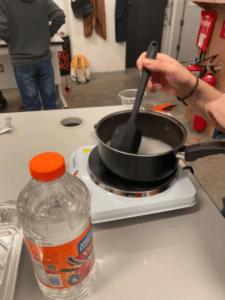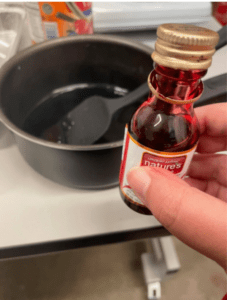Lab report – bio-materials
name: Ari Almansoori, Kevin Fernando Quiros Canales, Hannah Camille Greene
e-mail: aa7400@nyu.edu,kqc206@nyu.edu, hcg256@nyu.edu
Material :
The material made in the lab was bioplastic. Bioplastics are materials made of renewable biomass, such as vegetable fats and oils, corn starch, straw, woodchips, sawdust, and recovered food waste. Bioplastic can be produced using microorganisms from agricultural byproducts and even from recycled plastics.
Introduction or Purpose :
In this lab we attempted to produce bioplastics from household items. More specifically, there were two recipes for the preparation of potato starch and agar agar bioplastic.
In this experiment, the different ingredients required for the polymerization were mixed in a pot, which was then heated, following a different procedure for each bioplastic; finally, it was placed on a container and let dry. The quality and integrity of these bioplastics will be highly dependent on the proportions of the ingredients added to the mixture, the time this mixture had been in the hotplate and the time it had to dry. It has been hypothesized that bioplastics are both environmentally and economically friendly to make them a good alternative for plastic.
Ingredients and Amounts:
1.Potato starch bioplastic recipe:
- 160 mL Water
- 15 mL Vinegar
- 6 g Glycerol = 4.76 mL Glycerol
- 10 gr potato starch = 12.35 mL potato starch
- Agar agar bioplastic recipe:
- 119.6 mL Water
- 13.52 gr Vinegar =12.88 mL Vinegar
- 2.08 gr Glycerol= 1.65 mL Glycerol
- 4.42 gr Agar Agar = 4.42 mL Agar Agar
Tools:
- Stove
- Pot
- Scale
- Beakers
- Molds (trays)
- Spatula
- Dye
Methods:
1.Potato starch bioplastic recipe:
- Water, starch , and glycerol were mixed together in a pot.

- The stove was set to high heat and the pot was placed on it.
- The mixture was stirred until bubbles appeared.

- The mixture was stirred for 2 more minutes after bubbling.
- Blue and red dye were added to the mixture.

- The pot was removed from the stove, and the vinegar was mixed thoroughly with the mixture in the pot.
- The mix was poured in the mold.

- Agar agar bioplastic recipe:
- Water, Agar Agar , and glycerol were mixed together in a pot.

- The stove was set to 85ºC.
- The pot was placed on the stove, and the mixture was stirred for 10 minutes until viscous.

- The pot was removed from the stove, and the vinegar was mixed thoroughly with the mixture in the pot.
- Froth on the mixture was removed.
- The mix was poured in the mold.

Curing time and temperature:
- Agar agar:
The mixture was placed in the pan and heated at the level 3 of the hotplate for 10 minutes.
After this, the intensity was reduced to 1 while we were waiting for the other group to lend us the measuring cups.
An important observation is that we had to wait for another 10 minutes after the mixture was viscous until the other group lent us the measuring cups.
- Potato starch :
The mixture was placed over the hotplate at maximum power for 4 minutes, until bubbles started to appear at the bottom, and after that it was heated another 2 minutes; after which it was removed from the hot plate.
Due to the small amount it only took a few hours for our bioplastic to cure. It had already started drying by the time we left the lab.
Results: (photography):
1.Potato starch bioplastic recipe:

- Agar agar bioplastic recipe:

Physical aspect:
Both final products had a rather viscous feeling, somehow wet (which might be because it has not been left to dry yet) and quite fragile. The agar agar product was a little more difficult to manage, since it was very sticky.
Material observations according to external factors or changes over the time:
For both mixtures, it was observed that as they were being heated, they were becoming more viscous. It is also worth noting that the dyes used in the potato starch bioplastic were very dense, since just a small amount of the blue and red dye turned the mixture very dark.
*updated* Conclusions:
Both bioplastics were synthesized successfully, achieving for both an acceptable level of viscosity during the heating process. However, due to a delay from the heating process to the addition of vinegar, the agar agar mixture was allowed to dry excessively before being ready. This made it difficult to place the mixture in the aluminum container. This was noted as the structure of the agar agar was quite sticky and difficult to manage. It can be seen how non-trivial the preparation of bioplastics; which in a way, gives an insight on why it has been so difficult to achieve industrial levels as well as a wide reach of the public for these materials. Under optimal conditions, the hypothesis is confirmed. Although it is a tricky process it is more environmentally and economically friendly with respect to plastic.
In a week’s time we checked on our bioplastics. The Agar-agar one looked great. However the potato starch one seemed to have fungus growing on it. We believe that it might be going through bioplastic degradation. Different microorganisms such as bacteria, fungus, actinomycetes and others may degrade bioplastics. Some studies on bio-plastic degradation in the natural environment are conducted, although studies on the degradation of these polymers are not adequately gathered. So we don’t know what caused the degeneration in the lab. Humidity and moisture could have been because it’s in a basement.


Leave a Reply